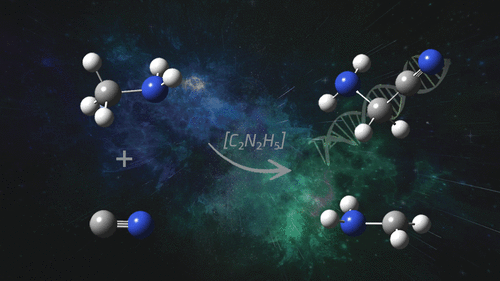当前位置:
X-MOL 学术
›
ACS Earth Space Chem.
›
论文详情
Our official English website, www.x-mol.net, welcomes your
feedback! (Note: you will need to create a separate account there.)
Exploring the Maze of C2N2H5 Radicals and Their Fragments in the Interstellar Medium with the Help of Quantum-Chemical Computations
ACS Earth and Space Chemistry ( IF 2.9 ) Pub Date : 2020-04-01 , DOI: 10.1021/acsearthspacechem.0c00062 Zoi Salta 1 , Nicola Tasinato 1 , Jacopo Lupi 1 , Rahma Boussessi 1 , Alice Balbi 1 , Cristina Puzzarini 2 , Vincenzo Barone 1
ACS Earth and Space Chemistry ( IF 2.9 ) Pub Date : 2020-04-01 , DOI: 10.1021/acsearthspacechem.0c00062 Zoi Salta 1 , Nicola Tasinato 1 , Jacopo Lupi 1 , Rahma Boussessi 1 , Alice Balbi 1 , Cristina Puzzarini 2 , Vincenzo Barone 1
Affiliation

|
Among the species discovered in the interstellar medium and planetary atmospheres, a crucial role is played by the so-called “interstellar” complex organic molecules (iCOMs) because they are the signature of the increasing molecular complexity in space. Indeed, they may represent the connection between simple molecules and biochemical species like amino acids and nucleobases. In particular, HCN and the related CN radical are the starting points of rich nitrile chemistry. In this framework, we have undertaken a computational investigation of the gas-phase reaction mechanisms involving different C2N2H5 radicals and their fragments, stemming from the addition of the cyano radical to the nitrogen atom of methylamine. Aiming at exploiting an accurate yet cost-effective protocol, a combination of CCSD(T)-based composite schemes and density functional theory has been employed. The exploration of the plausible chemical reaction channels has led to the identification of 12 different products, as well as 28 transition states connecting reactants, intermediates, and products. Aminoacetonitrile (H2NCH2CN), proposed as an intermediate in the formation of the smallest amino acid glycine, and the CH2NH2 radical appear as products energetically accessible under astrophysical conditions.
中文翻译:

借助量子化学计算探索星际介质中C 2 N 2 H 5自由基及其片段的迷宫
在星际中和行星大气中发现的物种中,所谓的“星际”复杂有机分子(iCOM)发挥着至关重要的作用,因为它们是空间中分子复杂性不断提高的标志。实际上,它们可能代表简单分子与氨基酸和核碱基等生化物种之间的联系。尤其是,HCN和相关的CN自由基是富腈化学的起点。在此框架下,我们对涉及不同C 2 N 2 H 5的气相反应机理进行了计算研究。自由基和它们的碎片,是由于将氰基自由基加到甲胺的氮原子上。为了开发一种准确而又具有成本效益的协议,已采用基于CCSD(T)的复合方案和密度泛函理论的组合。对可能的化学反应通道的探索已导致鉴定出12种不同的产物,以及28种连接反应物,中间体和产物的过渡态。氨基乙腈(H 2 NCH 2 CN),被提议作为最小氨基酸甘氨酸形成的中间体,而CH 2 NH 2自由基则是在天体条件下能以能量方式获得的产物。
更新日期:2020-04-01
中文翻译:

借助量子化学计算探索星际介质中C 2 N 2 H 5自由基及其片段的迷宫
在星际中和行星大气中发现的物种中,所谓的“星际”复杂有机分子(iCOM)发挥着至关重要的作用,因为它们是空间中分子复杂性不断提高的标志。实际上,它们可能代表简单分子与氨基酸和核碱基等生化物种之间的联系。尤其是,HCN和相关的CN自由基是富腈化学的起点。在此框架下,我们对涉及不同C 2 N 2 H 5的气相反应机理进行了计算研究。自由基和它们的碎片,是由于将氰基自由基加到甲胺的氮原子上。为了开发一种准确而又具有成本效益的协议,已采用基于CCSD(T)的复合方案和密度泛函理论的组合。对可能的化学反应通道的探索已导致鉴定出12种不同的产物,以及28种连接反应物,中间体和产物的过渡态。氨基乙腈(H 2 NCH 2 CN),被提议作为最小氨基酸甘氨酸形成的中间体,而CH 2 NH 2自由基则是在天体条件下能以能量方式获得的产物。











































 京公网安备 11010802027423号
京公网安备 11010802027423号